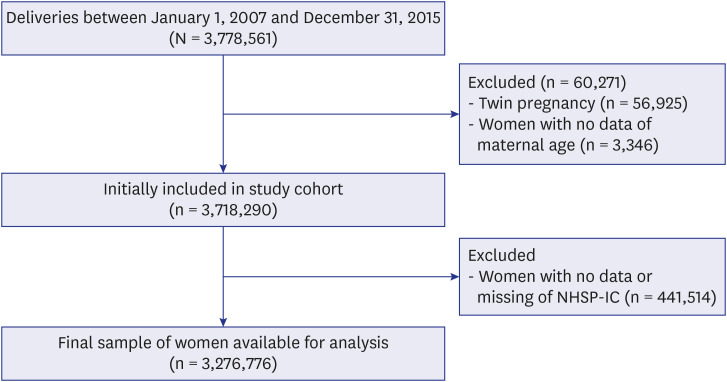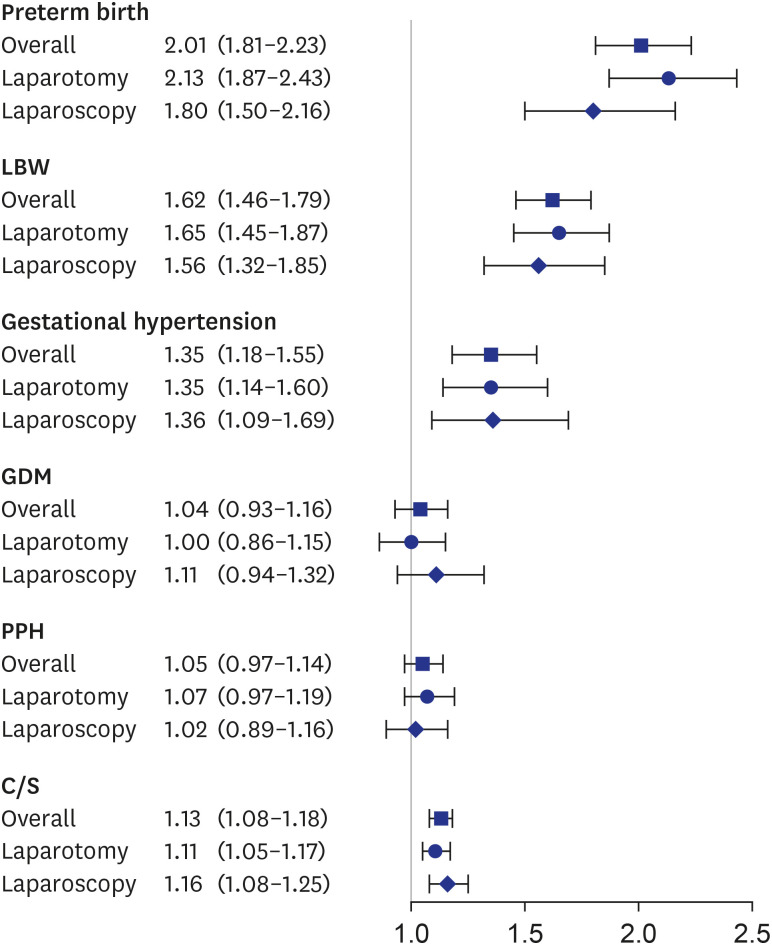J Korean Med Sci.
2021 Jul;36(29):e192. 10.3346/jkms.2021.36.e192.
Pregnancy Outcomes Following Laparoscopic and Open Surgery in Pelvis during Pregnancy: a Nationwide Population-based Study in Korea
- Affiliations
-
- 1Department of Obstetrics and Gynecology, Korea University Guro Hospital, Seoul, Korea
- 2Korea University Guro Hospital Smart Healthcare Center, Seoul, Korea
- KMID: 2518739
- DOI: http://doi.org/10.3346/jkms.2021.36.e192
Abstract
- Background
Non-obstetric surgery during pregnancy is associated with adverse obstetric and fetal outcomes. The aim of this study was to investigate the risk of adverse pregnancy outcomes for women who underwent non-obstetric pelvic surgery during pregnancy compared with that of women that did not undergo surgery.
Methods
Study data from women who gave birth in Korea were collected from the Korea National Health Insurance claims database between 2006 and 2016. We identified pregnant women who underwent abdominal non-obstetric pelvic surgery by laparoscopy or laparotomy from the database. Pregnancy outcomes including preterm birth, low birth weight (LBW), cesarean section (C/S), gestational hypertension, gestational diabetes, and postpartum hemorrhage were identified. The adjusted hazard ratios (HRs) and 95% confidence intervals (CIs) for the pregnancy outcomes were estimated by multivariate regression models.
Results
Data from 4,439,778 women were collected for this study. From 2006–2016, 9,417 women from the initial cohort underwent non-obstetric pelvic surgery (adnexal mass resection, appendectomy) during pregnancy. Multivariate logistic regression analysis indicated that preterm birth (HR, 2.01; 95% CI, 1.81–2.23), LBW (HR, 1.62; 95% CI, 1.46– 1.79), C/S (HR, 1.13; 95% CI, 1.08–1.18), and gestational hypertension (HR, 1.35; 95% CI, 1.18–1.55) were significantly more frequent in women who underwent non-obstetric surgery during pregnancy compared to pregnant women who did not undergo surgery. When the laparoscopic and laparotomy groups were compared for risk of fetal outcomes, the risk of LBW was significantly decreased in laparoscopic adnexal resection during pregnancy compared to laparotomy (odds ratio, 0.62; 95% CI, 0.40–0.95).
Conclusion
Non-obstetric pelvic surgery during pregnancy was associated with a higher risk of preterm birth, LBW, gestational hypertension, placenta previa, placental abruption, and C/S. Although the benefits and safety of laparoscopy during pregnancy appear similar to those of laparotomy in regard to pregnancy outcomes, laparoscopic adnexal mass resection was associated with a lower risk of LBW.
Figure
Reference
-
1. Rasmussen AS, Christiansen CF, Uldbjerg N, Nørgaard M. Obstetric and non-obstetric surgery during pregnancy: a 20-year Danish population-based prevalence study. BMJ Open. 2019; 9(5):e028136.
Article2. Duncan PG, Pope WD, Cohen MM, Greer N. Fetal risk of anesthesia and surgery during pregnancy. Anesthesiology. 1986; 64(6):790–794. PMID: 3717642.
Article3. Reedy MB, Källén B, Kuehl TJ. Laparoscopy during pregnancy: a study of five fetal outcome parameters with use of the Swedish Health Registry. Am J Obstet Gynecol. 1997; 177(3):673–679. PMID: 9322641.
Article4. Balinskaite V, Bottle A, Sodhi V, Rivers A, Bennett PR, Brett SJ, et al. The risk of adverse pregnancy outcomes following nonobstetric surgery during pregnancy: estimates from a retrospective cohort study of 6.5 million pregnancies. Ann Surg. 2017; 266(2):260–266. PMID: 27617856.5. Pearl JP, Price RR, Tonkin AE, Richardson WS, Stefanidis D. SAGES guidelines for the use of laparoscopy during pregnancy. Surg Endosc. 2017; 31(10):3767–3782. PMID: 28643072.
Article6. Bunyavejchevin S, Phupong V. Laparoscopic surgery for presumed benign ovarian tumor during pregnancy. Cochrane Database Syst Rev. 2013; (1):CD005459. PMID: 23440802.
Article7. Liu YX, Zhang Y, Huang JF, Wang L. Meta-analysis comparing the safety of laparoscopic and open surgical approaches for suspected adnexal mass during the second trimester. Int J Gynaecol Obstet. 2017; 136(3):272–279. PMID: 28099685.
Article8. Sedaghat N, Cao AM, Eslick GD, Cox MR. Laparoscopic versus open cholecystectomy in pregnancy: a systematic review and meta-analysis. Surg Endosc. 2017; 31(2):673–679. PMID: 27324332.
Article9. Walker HG, Al Samaraee A, Mills SJ, Kalbassi MR. Laparoscopic appendicectomy in pregnancy: a systematic review of the published evidence. Int J Surg. 2014; 12(11):1235–1241. PMID: 25219891.
Article10. Webb KE, Sakhel K, Chauhan SP, Abuhamad AZ. Adnexal mass during pregnancy: a review. Am J Perinatol. 2015; 32(11):1010–1016. PMID: 26007316.
Article11. Wilasrusmee C, Sukrat B, McEvoy M, Attia J, Thakkinstian A. Systematic review and meta-analysis of safety of laparoscopic versus open appendicectomy for suspected appendicitis in pregnancy. Br J Surg. 2012; 99(11):1470–1478. PMID: 23001791.
Article12. Shigemi D, Aso S, Matsui H, Fushimi K, Yasunaga H. Safety of laparoscopic surgery for benign diseases during pregnancy: a nationwide retrospective cohort study. J Minim Invasive Gynecol. 2019; 26(3):501–506. PMID: 29909089.
Article13. Yu CH, Weng SF, Ho CH, Chen YC, Chen JY, Chang YJ, et al. Pregnancy outcomes following nonobstetric surgery during gestation: a nationwide population-based case-control study in Taiwan. BMC Pregnancy Childbirth. 2018; 18(1):460. PMID: 30477448.
Article
- Full Text Links
- Actions
-
Cited
- CITED
-
- Close
- Share
- Similar articles
-
- A comparison of laparoscopic versus open appendectomy during pregnancy
- Safety of laparoscopic appendectomy for the management of acute appendicitis during pregnancy
- Laparoscopic Cholecystectomy in the Second Trimester of Pregnancy
- A Case of Laparoscopic Conservative Surgery for Ovarian Pregnany
- Suction and Evacuation of Ectopic Conceptus by Laparoscopic Cornuostomy in Interstitial Pregnancy: 2 cases



